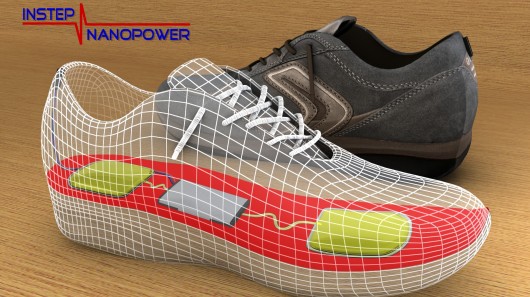 |
| Reviews and Templates for Expression We |
In-shoe device harvests energy created by walking
 Although you may not be using a Get Smart-style shoe phone anytime soon, it is possible that your mobile phone may end up receiving its power from your shoes. University of Wisconsin-Madison engineering researchers Tom Krupenkin and J. Ashley Taylor have developed an in-shoe system that harvests the energy generated by walking. Currently, this energy is lost as heat. With their technology, however, they claim that up to 20 watts of electricity could be generated, and stored in an incorporated rechargeable battery.
Although you may not be using a Get Smart-style shoe phone anytime soon, it is possible that your mobile phone may end up receiving its power from your shoes. University of Wisconsin-Madison engineering researchers Tom Krupenkin and J. Ashley Taylor have developed an in-shoe system that harvests the energy generated by walking. Currently, this energy is lost as heat. With their technology, however, they claim that up to 20 watts of electricity could be generated, and stored in an incorporated rechargeable battery.
While the details of the energy-harvesting technology are proprietary, it is said to involve a process known as "reverse electrowetting," which was discovered by Krupenkin and Taylor. It converts mechanical energy to electricity via a microfluidic device, in which thousands of moving microdroplets (of an undisclosed non-toxic, inexpensive liquid) interact with "a groundbreaking nanostructured substrate." The process is said to have a power density of up to one kilowatt per square meter (10.76 sq. ft.), plus it works with a wide range of mechanical forces, and is able to output a wide range of currents and voltages.
The battery is hermetically sealed, for protection against water and dirt. In order to get the power from it to the phone or other mobile device, the two would have to be temporarily physically joined with a wire, although the researchers are also looking into the use of conductive textiles and wireless inductive coupling.
Besides directly powering the phone, the device could also serve as a mobile WiFi hotspot, linking the phone to a wireless network. Having its own hotspot constantly nearby could drastically increase the phone's battery life - this is because the phone would only need to transmit in a low-power standard such as Bluetooth in order to reach the device, which would then use its own battery (which would be continuously getting recharged, by walking) for the high-power long-range transmissions to the network. Krupenkin claims that this could allow phone batteries to last up to ten times longer than normal.
The U Wisconsin technology is currently in the process of being commercialized, through Krupenkin and Taylor's company, InStep NanoPower. If it does make it to the marketplace, it may have some competition - Dr. Ville Kaajakari is also developing a piezoelectric device for shoes, that generates power as its user walks.
|
|
|
|
Copyright 2011 Energy and Technical Services Ltd. All Rights Reserved. Energyts.com |




